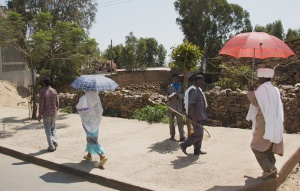Physical Activity and Non-Communicable Diseases
Original Editor - Chalchisa Abdeta
Top Contributors - Wendy Walker, Tony Lowe, Admin, Simisola Ajeyalemi, Kim Jackson, Michelle Lee and Rucha Gadgil
Non-Communicable Diseases[edit | edit source]
Non-Communicable Diseases (NCDs) is also known as chronic diseases that tend to last long durations and are not transferred from person to person (non-contagious). It is occurred as result of combined behavioural, physiological, environmental and genetic factors.
Mainly, it is happen due to modifiable behavioural factors. There are four main types of NCDs namely:-
- Cardiovascular diseases (like heart attacks and stroke)
- Cancers
- Chronic respiratory diseases (such as chronic obstructive pulmonary disease and asthma)
- Diabetes
Also, there are four major risks for the occurrence of NCDs:-
- Physical inactivity
- Unhealthy diets
- Tobacco use
- Harmful use of alcohol
Global Incidence of NCDs[edit | edit source]
All children, adults and elders are vulnerable to these four major risk factors. Globally, NCDs are killing 40 million peoples each year which accounts 70% of all deaths. Among these, 17 million peoples die from NCDs before 70 years of age (pre-mature death). Majority of these deaths (87%) were occurred in low-and middle-income countries. Figure 1 below is showing the four NCDs deaths in millions yearly[1].
For further information about the incidence of NCDs globally, as well the UN (United Nations) and WHO (World Health Organisation) efforts of combat NCDs, visit the Non-Communicable Diseases page.
NCDs and Physical Inactivity[edit | edit source]
Physical inactivity is the term used for not achieving the recommended physical activity for health. It is one of the major risk factors for non-communicable diseases (NCDs) which ranked as the fourth leading cause of death in the world.
It is become pandemic and a major global public health problem that needs urgent actions[2]. Inactive peoples are 20-30% times more likely at risk of death as compared to active ones. Evidences showed that 1 in 4 adults in the world are inactive. Globally, greater than 80% of adolescent population is physically inactive[3]. About 9% of all deaths recorded in the world are due to physical inactivity[4]. This showed that physical inactivity adds a greater burden to NCDs and pre-mature mortality. Currently, the world is working to decrease the prevalence of physical inactivity by 10% at the end of 2025[3].
Physical Activity Interventions[edit | edit source]
Evidences showed that physical inactivity is a big problem of the world that needs urgent interventions. It is important to plan physical inactivity interventions in line with the prevention and control of NCDs[2]. No single intervention is effective to increase physical activity level and beat NCDs; rather it needs comprehensive collaborative approach. Interventions should be friendly, funny, easy, simple, cheap and sustainable across the life span.
World Health Organization presented physical inactivity intervention in global action plan for prevention and control of NCDs[5] as follows:-
- Implementing public awareness and motivational communications including mass media for physical activity behavioral change.
- Establishing physical activity counseling and referral services at primary health care services.
- Implementing multi-component workplace friendly physical activity programs.
- Implementing community-wide friendly physical activity programs involving multiple settings and sectors
- Implementing whole-of-school program that support physical activity for all children.
- Implementing public transport systems that prioritize walking and cycling.
- Providing convenient and safe urban design and infrastructure to support side walking and cycling.
- Promoting physical activity through organized sport programs and events[6][7].
Physical Activity - definition[edit | edit source]
Physical activity is any body movement takes place by skeletal muscles that can expend more energies as World Health Organization (WHO) defined. It is a broader than exercises and physical fitness. It has three domains namely activities performed at workplace, during transportation and recreational time. Physical activity can be done in all age categories (from womb to tomb). It is not necessary requires special sport equipments, clothes and shoes. Engaging in physical activity is easy, cheap and do not take much time. So, we can easily accumulate few minutes of recommended physical activity every day across the lifespan[3].
References[edit | edit source]
References will automatically be added here, see adding references tutorial.
- ↑ WHO. Non-Communicable Diseases fact sheet. World Health Organization, Geneva, Switzerland. 2017; [/www.who.int/mediacentre/factsheets/fs355/en/ http://www.who.int/mediacentre/factsheets/fs355/en/] Accessed on 30th April, 2017
- ↑ 2.0 2.1 Kohl HW, Criag CL, Lambert EV, Inoue S, Alkandari JR, Leetongin G, Kahlmeier S. The pandemic of physical inactivity: global action for public health. Lancet physical activity series working group: The Lancet UK. 2012; 380:294–305.
- ↑ 3.0 3.1 3.2 WHO. Physical activity fact sheet. World Health Organization, Geneva, Switzerland.
- ↑ Lee IM, Shiroma EJ, Lobelo F, Puska P, Blair SN, Katzmarzyk PT. Effect of physical inactivity on major non-communicable diseases worldwide: an analysis of burden of disease and life expectancy. Lancet. 2012; 219:219–229.
- ↑ WHO. Global action plan for the prevention and control of NCDs 2013-2020: Updated appendix 3 of physical activity technical annex. World Health Organization Press. Geneva, Switzerland, 2017
- ↑ ISPAH. Global Advocacy for Physical Activity (GAPA) the Advocacy Council of the International Society for Physical Activity and Health (ISPAH). The Toronto Charter for Physical Activity: A Global Call to Action. May 20, 2010. Available from [/www.globalpa.org.uk/charter/ http://www.globalpa.org.uk/charter/]
- ↑ ISPAH. Global Advocacy for Physical Activity (GAPA) the Advocacy Council of the International Society for Physical Activity and Health (ISPAH). NCD Prevention: Investments that Work for Physical Activity. February 2011. Available from [/www.globalpa.org.uk/investmentsthatwork www.globalpa.org.uk/investmentsthatwork]







